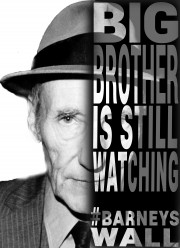
Barney Rosset was a free-speech warrior and radical publisher whose mid-century literary censorship battles against the US government blew open American culture, opening the door for Jay Z, Fifty Shades of Grey, "Game of Thrones," and Chris Rock. Barney's Wall, now on Kickstarter, tells the story of one man's hard-fought battle for the right of free expression.
NEW YORK, NY, March 31, 2016 (Newswire.com) - Imagine not being able to stream Jay Z or read Fifty Shades of Grey without being arrested! Without Barney Rosset battling the government’s powers of literary censorship and affirming "the freedom to read" in our First Amendment, our cultural landscape today might be vastly different. How are we going to remember this visionary leader?
A Kickstarter campaign is currently underway to finish filming a documentary called BARNEY’S WALL, which highlights Rosset’s battles for free expression through an astonishing 3D mural that he sculpted onto one long wall of his East Village loft.
"Without Barney Rosset, American culture as we now know it would not exist." - L.A. Times
Why would one of the greatest literary and free-speech figures of all time choose to leave his final thoughts not in words, but in symbols on a wall? Because this mural is a testament to Rosset’s vision of an insurgent, restlessly experimental world literature, a vision also expressed by many of the authors Rosset championed during his day such as William S. Burroughs, Malcom X, Jack Kerouac, John Kennedy Toole and more.
For over 100 years the Comstock Act passed by Congress allowed our federal government to ban, seize, and condemn books, films, and plays it deemed “obscene,” as well as contraceptives, aborifacients, erotica, and sex toys. From 1959 until 1964, as the publisher of Grove Press, Rosset defiantly challenged the government’s powers of censorship. In short order, he published three banned books of the time: D.H. Lawrence’s racy Lady Chatterly’s Lover, Henry Miller’s steamy Tropic of Cancer, and William S. Burrough’s Naked Lunch.
It took Rosset over three years of subsequent and ferocious court battles, all the way to the Supreme Court, before a landmark decision affirming the “freedom to read” brought down literary censorship, enabling radical writers to write freely. His effort nearly left him financially destitute, but it never broke his resolve to fight for freedom of expression.
And yet today, Rosset— ‘The Last Maverick of Publishing,’ as headlines called him—and his legacy are largely forgotten. Perhaps he feared how quickly we’d forget. Perhaps that’s why the lifelong friend and publisher of Samuel Beckett began painting the wall as his final act of free expression.
BARNEY’S WALL, the only record of Rosset’s mural, deciphers his visual autobiography with the help of some of New York City’s most notable cultural figures—publishers, editors, writers, artists—and a shaman. BARNEY’S WALL reveals the formative influences that drove a rebel, war photographer, filmmaker, and publisher to fiercely fight for freedom of expression.
Produced and directed by Sandy Gotham Meehan and Williams Cole, cinematography by David Leitner. View on www.barneyswall.com or on Kickstarter.
CONTACT:
Sandy Gotham Meehan
Producer
Barney’s Wall
T: 212-628-6810
E: info@barneyswall.com
Kickstarter Link: http://kck.st/1RymDCW
SCREEN MEDIA RESOURCES:
Website: www.barneyswall.com
Twitter: @barneyswall
Facebook: /barneyswall
Instagram: @barneyswall
Share: